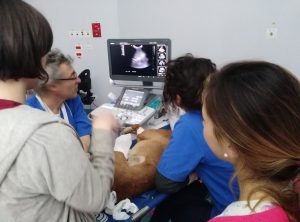A Large Deletion in the NSDHL Gene in Labrador Retrievers with a Congenital Cornification Disorder
Bauer A1,2, De Lucia M3, Jagannathan V1,2, Mezzalira G3, Casal ML4, Welle MM2,5, Leeb T6,2
A Large Deletion in the NSDHL Gene in Labrador Retrievers with a Congenital Cornification Disorder
G3 (Bethesda). 2017 Sep 7;7(9):3115-3121. doi: 10.1534/g3.117.1124.
Leggi online
Author information
1Institute of Genetics, Vetsuisse Faculty, University of Bern, 3001, Switzerland.2Dermfocus, Vetsuisse Faculty, University of Bern, 3001, Switzerland.3San Marco Veterinary Clinic and Laboratory, Padova 35141, Italy.4 Section of Medical Genetics, Department of Clinical Studies, School of Veterinary Medicine, University of Pennsylvania, Philadelphia, Pennsylvania 19104. 5 Institute of Animal Pathology, Vetsuisse Faculty, University of Bern, 3001, Switzerland. 6 Institute of Genetics, Vetsuisse Faculty, University of Bern, 3001, Switzerland tosso.leeb@vetsuisse.unibe.ch.
Abstract
In heterozygous females affected by an X-linked skin disorder, lesions often appear in a characteristic pattern, the so-called Blaschko’s lines. We investigated a female Labrador Retriever and her crossbred daughter, which both showed similar clinical lesions that followed Blaschko’s lines. The two male littermates of the affected daughter had died at birth, suggesting a monogenic X-chromosomal semidominant mode of inheritance. Whole genome sequencing of the affected daughter, and subsequent automated variant filtering with respect to 188 nonaffected control dogs of different breeds, revealed 332 hetero-zygous variants on the X-chromosome private to the affected dog. None of these variants was protein-changing. By visual inspection of candidate genes located on the X-chromosome, we identified a large deletion in the NSDHL gene, encoding NAD(P) dependent steroid dehydrogenase-like, a 3β-hydroxysteroid dehydrogenase involved in cholesterol biosynthesis. The deletion spanned >14 kb, and included the last three exons of the NSDHLgene. By PCR and fragment length analysis, we confirmed the presence of the variant in both affected dogs, and its absence in 50 control Labrador Retrievers. Variants in the NSDHL gene cause CHILD syndrome in humans, and the bare patches (Bpa) and striated (Str) phenotypes in mice. Taken together, our genetic data and the known role of NSDHL in X-linked skin disorders strongly suggest that the identified structural variant in the NSDHL gene is causative for the phenotype in the two affected dogs.






 Il Direttore Sanitario Dott. Marco Caldin
Il Direttore Sanitario Dott. Marco Caldin